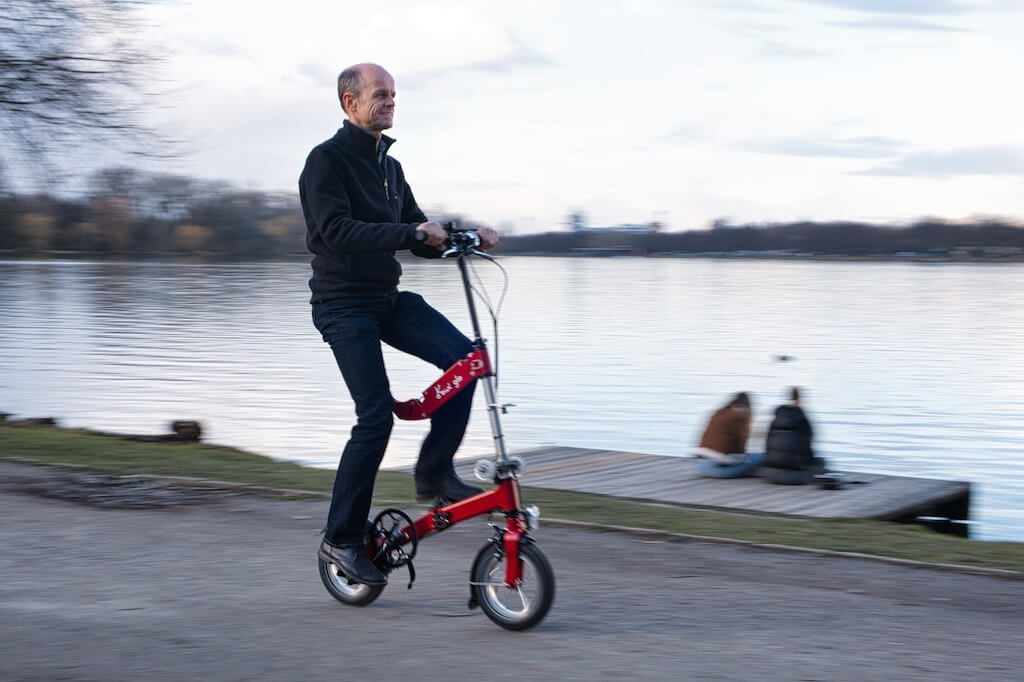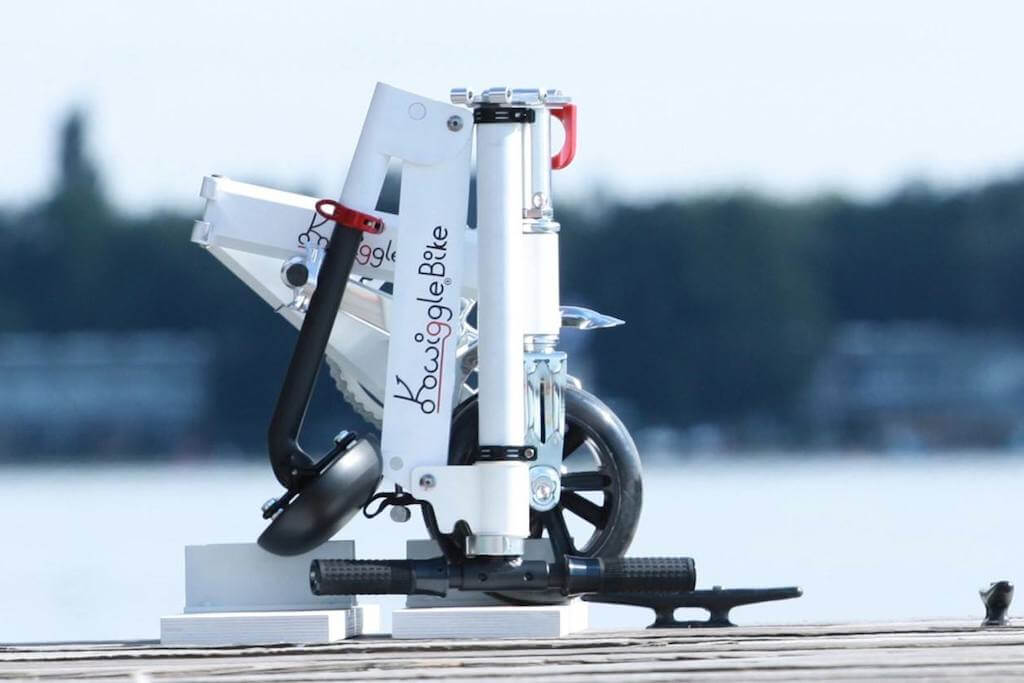Autumn Gear Guide
Find inspiration in our Gear Guide that will keep you out on your bike through wind or rain.
Download NowThe Kwiggle, a German bicycle that will soon be available in the U.S., has 12-inch wheels. The downtube is so low that it almost seems to skirt the ground. Instead of a seat post, it has an arm that bends away from the handlebars, like a robot that’s flexing its bicep. The seat is tiny, […]

The Kwiggle, a German bicycle that will soon be available in the U.S., has 12-inch wheels. The downtube is so low that it almost seems to skirt the ground. Instead of a seat post, it has an arm that bends away from the handlebars, like a robot that’s flexing its bicep. The seat is tiny, and it hovers over the rest of the machine. The bike looks impossible to ride — at first.
But then you watch people do it. They mount the bike in one fluid motion. Their posture is perfectly straight. Instead of bending over, the cyclist is basically standing up. Kwiggle riders look like they’re levitating through the air, steadied by a tiny handlebar.
The Kwiggle garnered international attention for its collapsible design: Its folded dimensions are about 22 inches by 15 inches by 10 inches, making it one of the most compact folding bikes ever made.
But the inventor of the Kwiggle, Karsten Bettin, wasn’t intent on making a folding bike. He wanted to create a bike that could be ridden standing upright.
Some years ago, Bettin was watching the Tour de France on television. As two lead riders pumped their way up a hill, they stood up. But one rider struggled to stand. He kept sitting back down on his saddle. He went back and forth like this, standing and sitting, in a torturous effort to out-muscle his opponent.
“I thought, ‘Why is it so hard for him to ride standing up for longer?’” Bettin says. “Surely he has eight hours every day to practice this crucial skill.”
Bettin is a mechanical engineer, and he’s also a lifelong cyclist, so the problem intrigued him. He tinkered with his design for years often taking apart children’s bikes in order to build his prototypes. Once he finished a version, he would test-ride it around the neighborhood.
“And the more mature the prototypes became, the more fun it was,” he says. “After each trip, I came to the same conclusion: Great riding is worth all this effort. There is rarely another device in the world that offers so much fun with this simultaneously physiologically optimal movement.”

Part of that “physiologically optimal movement” is the crooked seat-post. Unlike a regular bike, the Kwiggle’s post actually swivels back and forth. This helps the rider’s upright pose; instead of riders moving their hips to accommodate the pedals, the frame moves to accommodate riders’ hips. This innovation is the origin of the Kwiggle’s name: “wiggle” for the movement, and “K” for Karsten, the inventor’s first name.
This is arguably Bettin’s most important breakthrough, far more impressive than the Kwiggle’s other attributes, but it’s also the least obvious. If you’re passing a Kwiggle rider, you probably won’t notice that “wiggle” motion. In slo-mo, it’s far more evident.
It’s easy to think of Kwiggle as just a nifty machine. After all, Bettin has more than answered his initial question: Can you invent a bike that you ride standing up? The answer is, in a word, yes.
Yet Bettin believes that the Kwiggle’s ergonomic design makes it possible to ride extremely long distances, and he’s endeavored to prove this himself.
First, he rode around the IJsselmeer, a substantial body of water in the Netherlands. Over the course of 16 hours, Bettin pedaled 300 kilometers.
“Amazingly, I was then able to ride long stretches at a time, even with headwinds, before I needed a break,” he told me. “And even more amazingly, I restarted after breaks as if I were just starting the tour. All in all, a fantastic experience.”
Two hundred miles is an astonishing distance, even for Iron Man competitors, never mind soft spoken German engineers.
Like most of the Low Countries, the IJsselmeer is fairly flat. He needed a steeper test, so Bettin tried a 14-kilometer ride through the Alps, at an elevation of 1,000 meters. First he rode a racing bicycle, then he rode the same segment on a Kwiggle. The ascent was much smoother, he writes in his blog. Then there was the descent: He accelerated to 55 kmh, or roughly 35 mph, in what he playfully described as “slolem mode.”

Such velocity would be considered fast on a regular road bike, never mind a folding bike with eight-inch wheels.
Bettin grew up in Wolfsburg, a city best known as the headquarters of the Volkswagen motor company. Volkswagen dominates the town, and much of Bettin’s family has worked there. (Bettin appreciates the irony of his mission — to promote a greener alternative to private automobiles, even automobiles famous for their smallness and fuel efficiency.)
Bettin earned his degree in mechanical engineering from the Braunschweig Technical Institute in 1993 and worked in the field for more than two decades before incorporating Kwiggle around 2015.
Alongside Bettin is his son, Till, who has helped with the Kwiggle’s development and become a partner in the business. Till has helped with design details, training new workers, and quality control. He currently manages a team of 10 builders and coordinates with 35 different suppliers.
Bettin expects to enter the U.S. market this month.
To start, the company will ship its product directly from Germany. But it’s very possible that Kwiggle will open a brick-and-mortar store in a major American city, or even several. For now, it’s all up in the air.
“I think America is very big,” said Bettin, “and there are so many different people with different interests and preferences and so many uses for this compact folding bike: commuters, city travelers, parking lot seekers, sailors, sport flyers, boaters, fitness enthusiasts and many more.
“My conviction has always been that if I do something that helps a lot of people and brings them real benefits and maybe contributes to a better world, then business success will follow,” he adds. “If I had only wanted to make a business decision, I would have been better off doing other things like developing apps or something like that. I have enough ideas. In the end, however, it is important that you do something that corresponds to your deep inner conviction.”
Robert Isenberg is a writer and multimedia producer based in Providence, Rhode Island. You can find some of his essays about cycling on Medium.
Find inspiration in our Gear Guide that will keep you out on your bike through wind or rain.
Download Now
Is that fork on backwards? The fender is correct, but the brake is mounted on the back of the fork, which is the front of the fork , if the fork was turned around in the correct orientation.
Comments are closed.